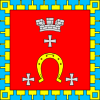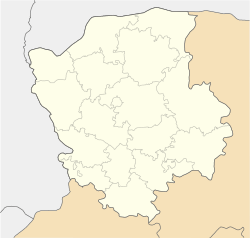Kovel
Kovel (Ukrainian: Ко́вель, romanized: Kovel’; Russian: Ковель, Polish: Kowel, Yiddish: קאָוועל) is a city in Volyn Oblast (province), in northwestern Ukraine. Serving as the administrative center of Kovel Raion (district), the town itself is designated as a town of oblast significance and is not part of the raion. Population: 69,342 (2015 est.)[2]
Kovel Ковель Kowel | |
|---|---|
 Square in Kovel, 2002 | |
 Flag  Coat of arms | |
 Kovel  Kovel | |
| Coordinates: 51°13′0″N 24°43′0″E | |
| Country | |
| Oblast | |
| Raion | Kovel City Municipality |
| Founded | 13th century |
| Magdeburg law | 1518 |
| Government | |
| • Mayor | Oleh Kinder[1] |
| Area | |
| • Total | 47.3 km2 (18.3 sq mi) |
| Population (2015) | |
| • Total | 69,342[2] |
| • Density | 1,400/km2 (4,000/sq mi) |
| Time zone | UTC+2 (EET) |
| • Summer (DST) | UTC+3 (EEST) |
| Postal code | 45000 |
| Area code(s) | +380 3352 |
| Website | Municipal official site in Ukrainian |
Kovel gives its name to one of the oldest runic inscriptions which were lost during World War II. The Kovel spearhead, unearthed near the town in 1858, contained text in Gothic (illustration).
History
The name Kovel comes from a Slavonic word for Blacksmith[3] hence the horseshoe on the town's coat of arms. The rune-inscribed Spearhead of Kovel was found near Kovel in 1858. It dates to the early 3rd century, when Gothic tribes lived in the area.
Kovel (Kowel) was first mentioned in 1310.[4] It received city rights from the Polish King Sigismund I the Old in 1518.[4] In 1547 the owner of Kowel became Bona Sforza, Polish queen.[4] In 1564 starost of Kowel became Kurbski (d. 1584).[4] From 1566 to 1795 it was part of the Volhynian Voivodeship. Kowel was a royal city of Poland.

After the late 18th century Partitions of Poland the town fell into the Russian Empire for over a hundred years. During the First World War, the city was a site of the Battle of Kovel between the Central Powers and the Russian Empire. In the interwar period, Kovel served as the capital of Kovel County in Volhynian Voivodeship of the Polish Republic. It was an important garrison of the Polish Army, here the headquarters of the 27th Volhynian Infantry Division was located. Furthermore, at the village of Czerkasy, a large depot of the Polish Army was located. In 1924, construction of the St. Stanislaus Bishop and Martyr Roman Catholic church began.
In World War II, following the Nazi German invasion of Poland and subsequently, their Operation Barbarossa the Germans murdered 18,000 Jews in Kovel, mostly during August and September 1942.
About 8,000 Jews were murdered in the forest near Bakhiv on August 19, 1942 during the liquidation of the Kovel ghetto, established on May 25, 1942. Jewish victims were driven by train from Kovel to Bakhiv where pits were dug close to the railroads. Actually there were two ghettos, one within the city and another in the suburbs of Pyaski. Both ghettos had 24,000 Jews, including many refugees. The Jews from both ghettos were executed at different places and at different time. The Jewish community ceased to exist.[6][7]
In March and April 1944, Kovel was a site of fierce fighting between the 5th SS Panzer Division Wiking and the Red Army.
During the Volhynian Genocide, the town was a shelter for ethnic Poles, escaping the genocide. In that period, Ukrainian nationalists murdered app. 3,700 Polish inhabitants of Kovel county. In early spring of 1944, the 27th Infantry Division of the Home Army operated in the area. Kovel was captured by the Red Army in July 1944. In 1945, the Big Three, Great Britain, the United States and the Soviet Union, established new borders for Poland; the Polish population was forcibly resettled and Kovel was incorporated into the Ukrainian Soviet Socialist Republic. It has been a part of sovereign Ukraine since 1991.
Climate
| Climate data for Kovel (1961–1990) | |||||||||||||
|---|---|---|---|---|---|---|---|---|---|---|---|---|---|
| Month | Jan | Feb | Mar | Apr | May | Jun | Jul | Aug | Sep | Oct | Nov | Dec | Year |
| Daily mean °C (°F) | −4.8 (23.4) |
−3.4 (25.9) |
1.0 (33.8) |
7.9 (46.2) |
13.7 (56.7) |
16.7 (62.1) |
18.0 (64.4) |
17.2 (63.0) |
13.0 (55.4) |
7.9 (46.2) |
2.6 (36.7) |
−1.8 (28.8) |
7.3 (45.1) |
| Average precipitation mm (inches) | 33 (1.3) |
31 (1.2) |
30 (1.2) |
39 (1.5) |
62 (2.4) |
75 (3.0) |
81 (3.2) |
63 (2.5) |
52 (2.0) |
37 (1.5) |
42 (1.7) |
40 (1.6) |
585 (23.0) |
| Source: NOAA[8] | |||||||||||||
Transportation
Kovel is the north-western hub of the Ukrainian rail system, with six rail lines radiating outward from the city. The first of these was built in 1873, connecting the city with Brest-Litovsk and Rivne. In 1877 Kovel was first linked by rail with Lublin and Warsaw in Congress Poland.
Notable people
- Lesya Ukrainka (1871–1913), Ukrainian poet
- Abraham Zapruder (1905–1970), clothing manufacturer who filmed the Assassination of John F. Kennedy
- Meir Auerbach (1815–1877), first Ashkenazi Chief Rabbi of Jerusalem.
- Israel Friedlander, rabbi, educator and biblical scholar
- Frieda Hennock, first female commissioner of the Federal Communications Commission
- Kazimierz Dejmek, Polish actor, theatre and film director
- Michał Waszyński, Polish (later American) film producer
- Ryszard Horodecki, Polish physicist, professor of University of Gdańsk
Twin towns – sister cities
References
- "Municipal official site in Ukrainian".
- "Чисельність наявного населення України (Actual population of Ukraine)" (PDF) (in Ukrainian). State Statistics Service of Ukraine. Retrieved 1 July 2016.
- https://www.houseofnames.com/Kovel-family-crest/Polish
- Rąkowski, Grzegorz (2005). Wołyń. Pruszków: Oficyna Wydawnicza "Rewasz". p. 85. ISBN 83-89188-32-5.
- Photograph from the Boris Feldblyum Collection
- http://yahadmap.org/#village/bakhiv-volyn-ukraine.4
- http://www.protecting-memory.org/en/memorial-sites/bakhiv-2/
- "Kovel Climate Normals 1961-1990". National Oceanic and Atmospheric Administration. Retrieved September 29, 2016.
- "Міста партнери". kovelrada.gov.ua (in Ukrainian). Kovel. Retrieved 2020-03-31.
External links
| Wikimedia Commons has media related to Kovel. |
- Kovel News (in Ukrainian)
- Short history of Kowel (in English)
- Carrier "Kowel" leased by Poland during World War II
- Tineke Looijenga, Texts & contexts of the oldest Runic inscriptions Published by BRILL. Page 127
- A Testament of a Jewish Woman from Kowel, Poland Source: Safira Rapoport (Ed.), Yesterdays and then Tomorrows, Yad Vashem 2002, p. 183 (in the Hebrew edition).
- David Pentland, "Fight for Kowel, Poland, March/April 1944", Gerhard Fischer Knights Cross signature series
- Historic images of Kovel
- Soviet topographic map 1:100 000
- Photos of Kovel at "Ukraine Photos"
- http://www.shtetlinks.jewishgen.org/kovel/kovel.htm
- http://www.israeli-kovel-org.org/english.html